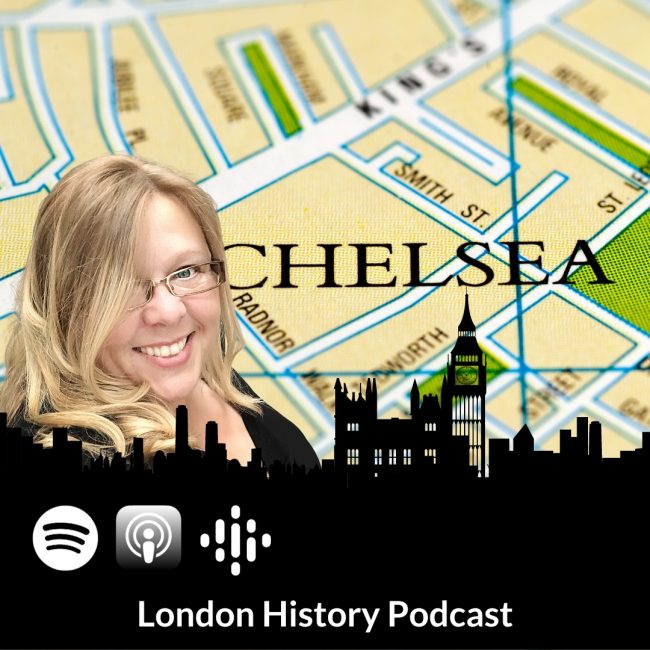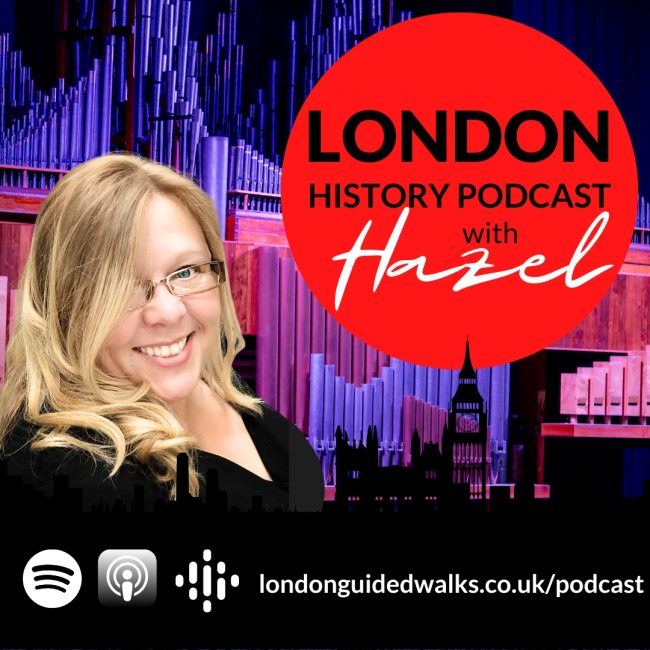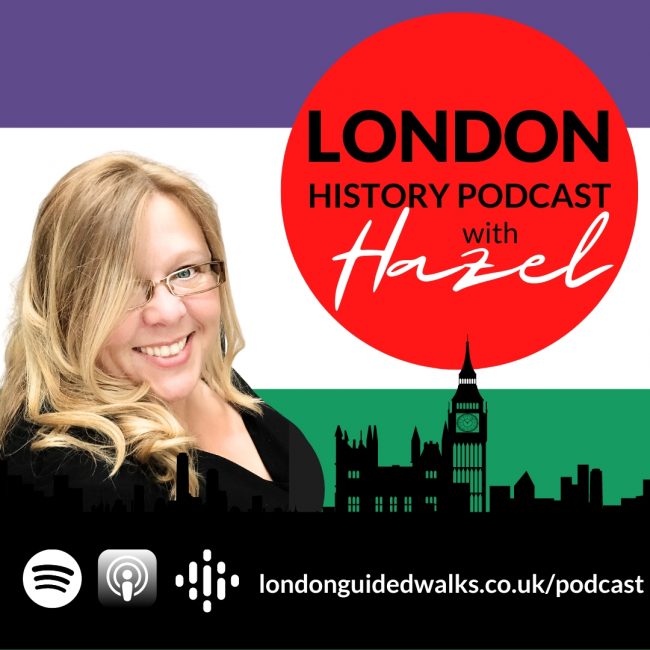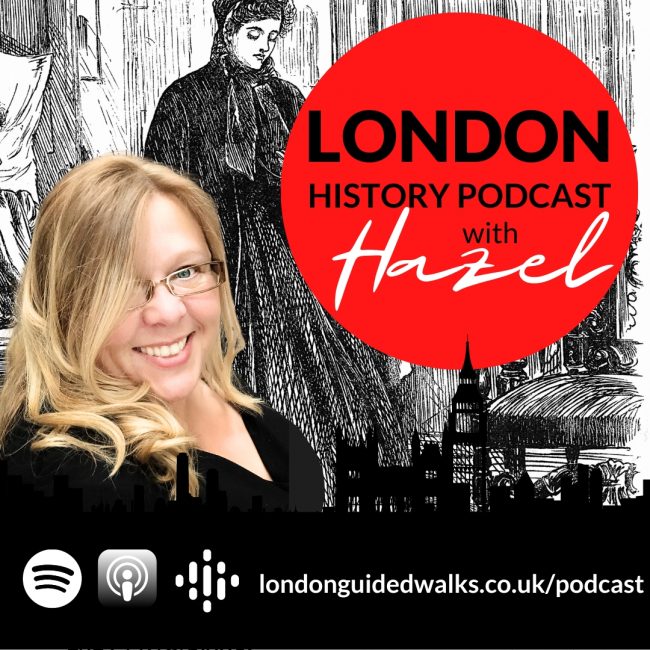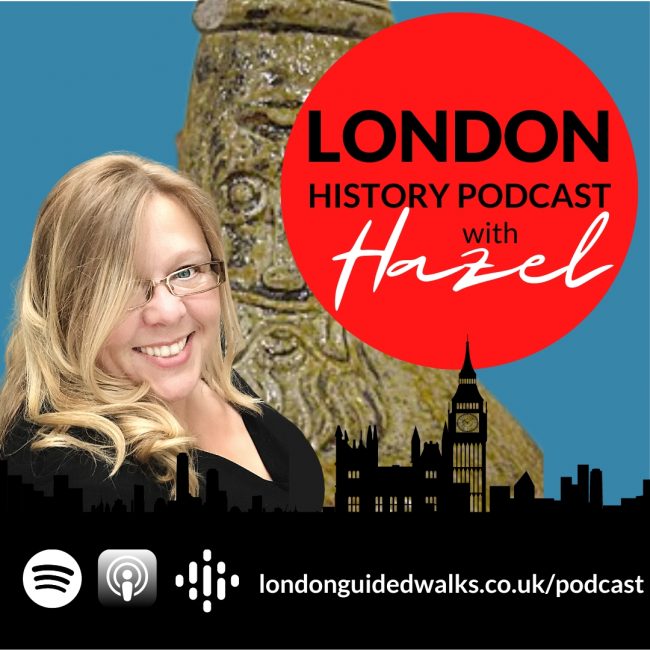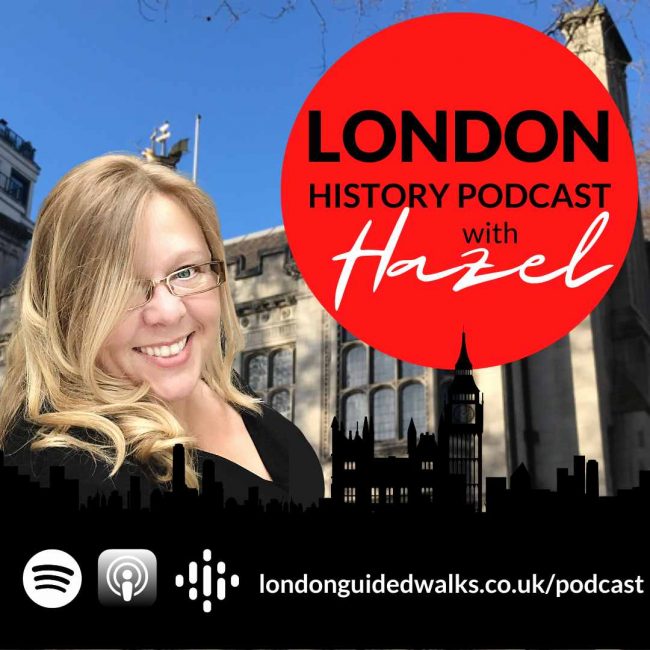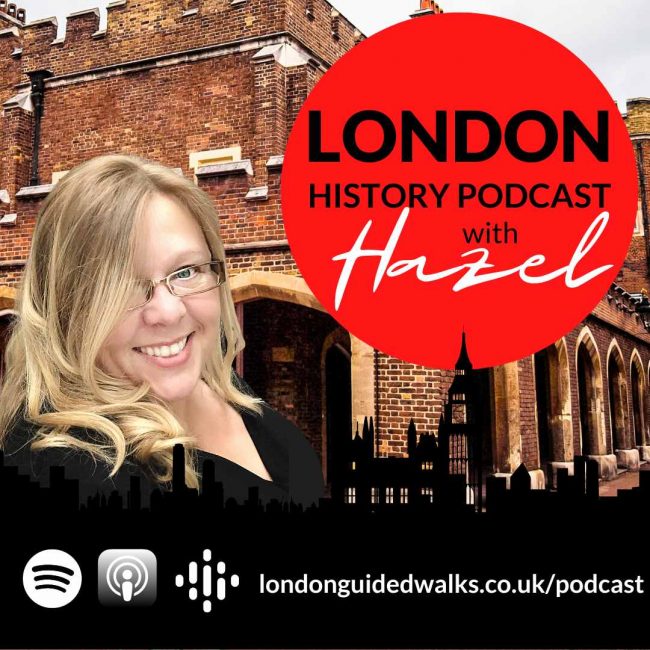History of Tite Street Transcript:
Hazel: Hello, and welcome to our London History podcast, where we share our love of London. It’s people, places, and history. It’s designed for you to learn things about London that most Londoners don’t even know. I am your host, Hazel Baker, a Qualified London Tour Guide and CEO and founder of londonguidedwalk.co uk
Each episode is supported by show notes, transcripts, photos and further reading, all to be found on our website. Click on londonguidedwalks.co.uk/podcast and then select the episode that you fancy. And if you enjoy what we do, then you’ll love our guided walks and private tours that we offer throughout the year.
So get that cup of tea, put your feet up and enjoy.
This week we delve into the enchanting tale of Tite Street, a venerable avenue in the heart of Chelsea that serves as a living gallery to the artistic and literary greats of bygone days. Before we wander through the history that permeates every brick and cobblestone of Tide Street, let us orientate ourselves with a brief journey there.
Should you wish to follow in the footsteps of the iconic figures we’re about to discuss, you should start from Sloane Square tube station. Upon exiting the station, take a left onto Lower Sloane Street and continue as it merges into Sloane Gardens, then bear right onto Holbein Place. A gentle stroll down and turn left onto Chelsea Bridge Road, and soon after a right turn will guide you onto Royal Hospital Road.
As you proceed, a left turn onto Tite Street is where your historical adventure would begin. Now, back to our episode and the esteemed presence of our guest, Dr. Stephen King, a City of Westminster tour guide, offering walking tours on behalf of London Guided Walks. Stephen brings with him a trove of knowledge, particularly about Tite Street, which was a nucleus of London’s aesthetic movement, and that’s because he also offers a walking tour in Chelsea.
Tite Street, T I T E, was once a simple footpath. Bordering Market Gardens, and it’s transformed into an avenue where the avant garde of Victorian society convened. Icons like Oscar Wilde and James McNeill Whistler brought a flourish of creativity and non conformity to the street, which became a byword for artistic excellence and innovation.
As I talk with Stephen King, we’ll traverse the timeline that we saw Tite Street evolve from the 18th century origins to the 19th century haven for artists and further into its modern day incarnation too. Our discussion will touch upon the architectural splendor that rose from its foundations in the 1870s, the illustrious lives of its residents, and the cultural and social tides that have washed over it through the decades.
Tite Street’s story is interwoven with the broader historical fabric of Chelsea, reflecting the district’s transformation and the indomitable spirit of the city itself. It’s a tale of continuity and change, resilience and renewal. Hello Stephen.
[00:03:39] Stephen King: Hello Hazel, how are you?
[00:03:42] Hazel: Yeah, really good, thank you. Getting ready for our Christmas walks, which are going to be good. so I think it might be worth starting off, Stephen, with how Tite Street got its name, because it’s not an obvious word that we use, is it?
[00:03:58] Stephen King: that’s a very good point. So there was a guy called William Tite, who was 1798-1873. He was one of these kind of illustrious, Victorians that you often hear about. He ended up, he was an architect. he ended up being president of the Royal Institution of British Architects, RIBA, but he also was the MP for Bath until he, he, for about 20 years. But the reason it’s called Tite Street is because, he was on the board of the Metropolitan Board of Works.
You probably know them, they’re most famous with, Bazalgette and the drains, but the Metropolitan Board of Works were doing various things, and one of which was the, the embankment. Which is obviously, basal jets, drains, sit famously underneath the embankment. And when they were about to build an extended out to Chelsea, with the embankment going along the Thames there, they basically ran out of money.
and, William Tite was one of the people instrumental. In raising the money to, build the, Chelsea Embankment, and also the, the famous lovely, Albert Bridge there, the, that beautiful bridge. Tite is, not really that famous. I think he’s, famous for two things, very much about the architecture of the time.
He’s famous for having built the the Royal Exchange. That, thing that looks like a Greek temple opposite the Bank of England in the, heart of the city. he’s famous for doing that in the 1840s. But he’s also, also famous for vehemently… objecting to Gilbert Scott’s design for the Foreign Office.
even though the, the Royal Exchange is very much a classical building, Tite believed that the, the Foreign Office should be in the Gothic style, and he objected very much to, Gilbert Scott’s classical Foreign Office, but what you can see now on the… On Whitehall, you can see that obviously, Scott won and Tite didn’t.
and those are the kind of the two things that he’s most famous for. And when William Tite died in the, in 1873, uh, the embankment being built out, Tite Street gets developed in the, in the later 1870s. And as a fitting monument for Sir William, they decided to name the street after him. So that’s the origin of, why it’s called Tite Street.
Yeah, perhaps
[00:06:28] Hazel: it would be worth, giving a little bit of background as to Chelsea
[00:06:32] Stephen King: itself. Yeah, of course. So Chelsea obviously, as sits about two miles down river from, from Whitehall and Westminster. So if you’re travelling back towards Hampton Court, going, Upstream to, to there, that’s where Chelsea sits.
So it’s on the Thames, but it’s a very ancient place. Chelsea, the name Chelsea is Anglo Saxon, meaning, white landing, referring to the, chalk outcrops there. and, just by Battersea Bridge, if you know the area, that’s where King Canute, the guy who famously tried to, turn back the tide, that’s where he had one of his palaces.
And, when Bassie Bridge was being built, they actually found a, an Anglo Saxon, shield, which you can go into the British Museum and see. it’s a long history. Chelsea Old Church, first, noted in 1175. but then it, sits in the countryside. for many centuries.
big manor houses were, built there. one of the most famous ones was built by Henry VIII. He had an enormous manor house there, of which played an important role in, in, in Tudor Britain. Elizabeth I lived there. As you can see there, there was a long history. up there, but it sits there in countryside, close to London, but, far enough away to be, to be, a nice kind of country retreat almost.
And a nice
[00:08:06] Hazel: distance of London to, stay away from the plague,
[00:08:10] Stephen King: Precisely ideal for getting away from the play. You can see why Henry VIII liked it because, it was halfway between Hampton Court and Whitehall and yet in the countryside and you could, you could hide out there and you could put your children there quite safely in the countryside, with the fresh air and the fresh water.
So it sits there, and then we get one of the first famous names along the time, Sir Hans Sloane, who gives his name to large areas of this part of the world, Sloane Square, for example. So he’s in the, in the 18th century, and he buys basically the manor of Chelsea, and we could, talk about the origin where his money gets in, comes from.
Sir Hans Sloane, famously the man who, invented, hot chocolate, so they claim. but he dies, his, estate goes to Elizabeth, and then she marries the second baron of Cadogan, another name you see all over Chelsea, and the Cadogans still own Chelsea. to this day. and, and they own, large swathes of Chelsea, to this day.
I think they own, I’m just checking my notes, they own about 3, 000 flats, 200 houses, 300 shops, and 15 acres of, of parkland, still in Chelsea. So not, doing badly, the Cadogan’s. and, but then, like I say, the, real change comes in the 1860s. and two things drive the development of Chelsea.
One is, the opening of the tube station, Sloane Square tube station, opens up in the, the late 1860s. And then we get the, building. of the, Chelsea Embankment we mentioned earlier at the same time. So suddenly it becomes prime development land. you’ve got the connections into the West End, and suddenly that muddy swamp that was the edge of the River Thames becomes this beautiful kind of Parisian, thoroughfare.
but it’s still empty land. and, Tite Street, the land in Tite Street is owned by the Metropolitan Board of Works. and they are selling off little parcels of land, to develop and, build on. And one of the first parcels of land that’s sold is bought by the American painter Whistler. And he wants to develop it out as, as very much an artist studio.
Now, James Whistler comes, he’s American. Spends hardly any time, like a lot of the people we’re going to meet in this discussion. They may be American, but they hardly ever live in America. and he gets a, an architect to design in the house, Godwin. And, Godwin’s very artistically minded as well.
He designs this wonderful house. And basically, the Metropolitan Board of Work say, No, we’re not having it. We don’t like the design. and, there’s a massive argument. Godwin basically, shall we say, is a little open with a truth in terms of what the design looks like and eventually gets it past the Metropolitan Board of Works.
But it does get voted down by them a number of times. So eventually this house is built, the White House, and that’s one of the first buildings along Tide Street, for James Whistler. James Whistler then decides he’s quite a cantankerous person. There’s no bedding away. He does like an argument as James Whistler, and he has, he basically then ends up having a massive argument with the art critic Ruskin.
They go to court, over libel. Whistler wins. but he gets a massive award of one pound. he’s basically made himself bankrupt by this legal activity. and he then never actually gets to live in the White House, in this wonderful house that Godwin’s built for him. He basically has to go to, to Italy, bankrupt.
Though he does return at later times to, to Tite Street. So that’s the kind of, the kind of origin of the
[00:12:21] Hazel: area. So not a great start for the beginnings of Tite Street then?
[00:12:25] Stephen King: Not a great start, no, you can, claim, but that is the marker. And, then it, Godwin rapidly develops a number of houses, bespoke, artist studios for people along there.
And so we can see some, wonderful. buildings, developed there. And then you get little, asides like the son of, Mary Shelley actually has a house built for him along Tite street as well. and that is one of those kind of eccentric little houses that, not that little, it actually has a 200 seat theater, tucked away on Tite street.
and, that house, was there for a number of years. And like I said, the son of, Mary Shelley has plays. put on in, in there. And eventually one of his neighbors ends up taking him to court and he ends up, having to close down his theater as well. So it was, like lots of. artistic activities, quite bohemian from the start, and always popular with, with Americans, traveling in Europe as well.
And John Singer Sargent, pops up in the 1880s, again to be associated. with this road, and, and you can see his house to this day. Interestingly enough, Whistler’s house, the white house, got demolished in the 1960s. and so that no longer exists. But the wonderful thing about Tide Street is you can see all these amazing houses still that were developed for all these, artists who lived along it.
So as you’ve mentioned,
[00:14:02] Hazel: Chelsea’s a little bit further out of, from the West End. So what was it about Chelsea specifically that was attractive for the artistic types?
[00:14:12] Stephen King: Yeah, that’s a really good question. Why Chelsea? a whole range of reasons. Partly it was just a bit cheaper, because it was being developed out.
it was new. Partly it was quite close to the West End and to the, the rich people of Belgravia. basically your clients. So they could ease people like Sargent made his name by painting the affluent individuals of Edwardian Britain. And they would travel, to Tite street to get painted.
Sargent paints over 900 oil paintings in his time. and some of the most famous names, turn up at Tite street. One of the reasons Tite Street’s popular is you can get to it quite easily, but it was also quite cheap. And one of the other attractions, interestingly enough, was the, River Thames.
Turner, at the end of his life, a little earlier, actually hides out as an old man in, in Chelsea because he just wants to be by the Thames and he loves watching the colors change on the Thames. Whistler was always drawn to the Thames as well. You can go into the Tate Britain and see a wonderful painting of what was the old Bassie Bridge when Bassie Bridge was a wooden bridge.
And actually, if you go to Bassie Bridge now, there’s a painting of Turner standing there by Bassie Bridge, easel in hand. And then it just, as you said, it got, there was a domino effect. There was, it, was known as a bohemian area. And it was where people of a bohemian, background went to.
There’s a lovely story. and that kind of lasts into the post war period, into the 1950s. There’s a lovely story of, somebody saying, the thing about Chelsea is, I can leave my front door. in my dressing gown and wander. And I know I’ve left Chelsea when people start looking at me strangely when I’m in my dressing gown.
It was just that kind of bohemian relaxed kind of atmosphere. You
[00:16:10] Hazel: mentioned some of the big artistic names associated with Tite Street, and what impact did they have on the street’s reputation?
[00:16:19] Stephen King: The, reputation of Tite Street was very much like a bohemian area to hang out. and people
[00:16:26] Hazel: like a bit like a Mamata in Paris.
[00:16:29] Stephen King: Yes, exactly. Exactly. And, in fact, people would often come from Paris. So Whistler initially started his career in Paris, Sergeant actually comes to Tite Street having to, having had to flee Paris because he does this infamous painting of this young society lady. It’s called, and it’s so scandalous that, he has to basically flee Paris and another, American, Henry James, the writer basically convinces him that Chelsea is the place to be, and where you can hang out.
But it was also interesting, the, you had a certain degree of respectability around it. you couldn’t be completely bohemian because you were selling your, paintings to the, to the, wealthy. but there was always this tension with say the Royal Academy, people like Whistler steadfastly refused to be, to join the Royal Academy.
he just saw them as old duffers that had nothing to do with him. Yeah, it was a wonderful, artistic melee of people. I think you could write a whole book and thesis on, Whistler and his approach to women. There was a lot of, there was a lot of affairs going on, a lot of, general, activity that wouldn’t be seen as.
particularly respectable by Victorians.
[00:17:55] Hazel: And perhaps the, the distance from the West End was advantageous as well. You could get away with a few things that you might not have been able to in the West
[00:18:04] Stephen King: End. Yes, indeed. Indeed, you could get away with stuff in Chelsea that you couldn’t get away with in, in, St James’s, probably.
Yes, exactly. And
[00:18:13] Hazel: how has the architecture of Tite Street, evolved over time? Are there any buildings of particular historical or architectural importance that have managed to survive the 1960s?
[00:18:26] Stephen King: The architecture there is surprisingly well kept. you can stand there and you can look up at these buildings and you just see these enormous windows.
And you can see that they were, very much designed as artist studios, and there’s some which are layered on top of each other in terms of the actual studios. You can see a number of floors, where you’ve just got these great big open glass windows that have, survived amazingly well over the time.
I don’t think there are artist studios anymore, sadly. famously though, right until, The 1990s, actually in the house where Sargent did so many of his paintings, there were two people, in 1994, there were two people coming and arriving at 30 Tite Street, being painted by the American artist, Nelson Shanks.
One, he was painting, a painting of Princess Diana. and that was apparently, quite relaxed and, he was, doing a, commission for, that. And the other one, he was commissioned by the National, by the National Portrait Gallery to do a painting of Margaret Thatcher, which apparently was a, she was, unsurprisingly enough, a very different type of sitter.
She would sit there ramrod, and straight. And even when he went to, clean his brushes or have a cup of tea, she would virtually not move. So yes, it’s amazing the continuity that has been seen through there from, these paintings taking place in the, mid 90s in the exact same studio that John Singer Sargent was painting.
see that, that is what I love about the street is you can imagine. The history there because you can see the houses. and there’s a wonderful book written just about Tite Street. It’s called, The Street of Wonderful Possibilities, by this American writer called, Devin Cox.
The title, The Street of Wonderful Possibilities, comes from the fact that Oscar Wilde, who lived on the street, was sitting in his window, looking, sitting in his library at the front of his house, looking out of his window, and suddenly a carriage comes along Tite Street, and then, the amazing actress, Elaine Terry, steps out of this carriage.
in full costume, of Lady, Macbeth. She’s wearing this amazing costume. She’s got a wig, an auburn wig that goes down to our ankles and she just steps out and walks into Sargent’s, studio and he just says, the, this vision. To, see M’lady Macbeth stepping out of a carriage, in, in Titan Street.
This is a street of wonderful possibilities. And if you want to see that painting of Elly and Terry, it does actually, it’s now, in the National Portrait Gallery and it is quite stunning. Oscar
[00:21:31] Hazel: Wilde is one of Tite Street’s most famous former residents. How did his life and works interact with the local community during his time there?
[00:21:43] Stephen King: Tite Street was central to the Oscar Wilde story. Tite Street, Oscar Wilde moves to Tite Street initially as a bachelor, after he leaves Oxford. Although he has an enormous row with his, housemate. and there’s a famous story how he, storms out having thrown a, an enormous suitcase from the top floor down the stairs, which then crashes onto a table, destroying it.
and then he, storms out, but he returns. To Tite Street, interestingly enough, as a married man, as a happily married man with, Constance, his wife, he has two sons there, and in many ways, it’s a, it’s an odd story because at that stage, he, he’s living at, on, on Tite Street with his two sons, he gets up every morning, or, twice a week, gets up, walks to Sloane Square, gets the tube, and then, oddly enough, edits a women’s magazine.
He’s the editor of Ladies World. And Woman’s World for a number of, months while he’s living there, but that doesn’t go so, go, so well. Him and the editor don’t really get on, but, but if you go, there’s a blue plaque to Oscar Wilde on Tite Street, and when you stand there, that’s where you get the sense of history, because that blue plaque is next to the library, and then that is the room where he basically, over 10 years, he wrote The Happy Prince in 1888, Dorian Gray 1891, then Lady Winnipeg.
Lady Winham is fan 1892. Then we have the ideal husband. And then finally, the importance of being earnest 18, 95. And just to think all on Tite Street. Yes, all amazing. Admittedly, some of those were, may have been written in hotels, but certainly towards the end when in, when the marriage with Constance wasn’t going so well, shall we say?
but yes, no, a lot of the, that was written in that room and that’s an amazing sense of history. from standing there. But of course, that is where the site of Oscar Wilde’s downfall was as well, because that is where, and, you can do, and this is the amazing thing. You stand out there and you can see, the doorway, the room, and, that is where the, famously the Marquis of Queensbury in, 1894 barges in.
Through the, pa through past his, butler, and storms in and confronts Oscar Wilde in his, in his library in that front room and accuses him of having an affair with his son Bosie. and, again, that, that is what happened. right there, it’s one of those places where you think, this is, where it happened, this is where the history was.
It’s one of those times where it’s. You know what it’s like being a tour guide where you can say something to a guest and they just their breath goes in and they think, wow, that, that, was here. and that’s the amazing thing about, about Tide Street is that history with Oscar.
And again, it’s, we know the story, Oscar Wilde takes the Marcus of Queensborough to libel. And the libel fails, and then we get the two other court cases that, that leads to the demise of Oscar Wilde. And, again, he’s, now, by that stage, left Tite Street. Constance and the two sons, move, out.
And it’s very tragic. Constance dies, before Oscar Wilde does, it’s, all a very, a tragic story, but, that, that is where they, lived and grew up and it’s interesting, the two sons, there’s a behind Tite Street, there’s a tiny little kind of, it’s not quite amused, but it feels like it could be amused called Paradise Walk, and that’s a very dark name because Paradise Walk was actually one of the Poorest areas of, of Chelsea.
it was very much a slum. And it’s interesting that the, the Oscar Wilde boys would, go from Tite street and literally walk two minutes around the corner and give food parcels to the poor people of, of, paradise walk to, a degree. They got two famous, because the, the poor of, of.
Paradise Walk would then return the favor and walk back round and knock on Oscar Wilde’s door and pester Constance for, for food and, and, and money as well. it was an interesting mixture of people that lived there. Now, of course, to buy anything on Paradise Walk, you’ll need to be a millionaire, but, it’s funny how things change.
[00:26:23] Hazel: Keep on with those walking tours, Stephen, you’ll get there.
[00:26:27] Stephen King: I think my main house I’d like to buy in Chelsea is the one that overlooks the, the, the Physick Garden. I must admit, I stand and look at that gorgeous house and the view of the, Chelsea Physick Garden and think, Yeah, that, that’s probably the one I’d like, Hayes.
Could you
[00:26:42] Hazel: discuss the social dynamics of Tite Street during the late 19th and early 20th century? Was it considered a fashionable location? And if so, what were the contributing factors? Chelsea
[00:26:57] Stephen King: never really at that stage, it didn’t have the size of houses that you’d see in Belgravia. So it was never a place where Marquis’s would hang out.
the, houses were generally smaller and there were a lot of flats developed. In the area as well, a lot of, very nice flats, but they were flats. And so what you got was maybe the sons of famous people moving there, or the sons of barons and, people there. interesting.
To my mind, one of the, one of the famous people, that kind of intersects my interests is somebody called John Collier, who was a painter there. and he was the son of, a very wealthy, yes, he basically was a, one of those people that ends up running half the empire kind of people. and John Collier is a painter and he moves there.
Interestingly enough, he marries somebody, who’s the, the daughter of, Thomas, Huxley. Thomas Huxley was one of, Charles Darwin’s greatest advocates, and they married in 1879 and they lived there again on Tite Street, but Marion, the daughter, sadly gets into postnatal depression, after they have their first daughter and then, it’s very tragic.
She dies in 1887 having lived there. But what I find then is interesting about John Collier, he’s then asked by the Linnaean Society to go and paint Darwin, in, 1881. And if you know that, that amazing painting in the National Portrait Gallery, the elderly Darwin standing there, holding his hat, staring out at you.
That was John Collier who did, who painted that. He didn’t paint it in Tite Street. Darwin famously was, recluse. So he had to go down to Down House, to paint him. But, just that intersection of people who lived there and, the way they related to the rest of kind of what was happening in, in, London at the time is fascinating.
[00:29:06] Hazel: Are there any lesser known figures who resided on Tite Street whose contributions to? History or culture may have been
[00:29:14] Stephen King: overlooked. Oh, there’s so many different people there. There’s, a plaque to somebody called Lord Haddon Guest, who, he was a, Labour politician, he was a, a doctor, and, famously organised the evacuation of school children from London.
so people like that. There was somebody called, Peter Warlock, who was a composer. Who also has a, plaque there, if you’re into, early medieval music, he was one of the people in the kind of Edwardian period who, codified that. interesting enough, Peter Warlock didn’t really, not most famous for living on Tite Street, most famous for actually dying on Tite Street.
He gassed, he gassed himself, sadly, actually, where that blue plaque is there is the, room where, he turned on the oven and, Gas himself with coal gas. So there’s tragic stories there as well. and, there, there’s also some famous female artists as well. They’re an American artist called Anneli Marriott, live there.
and you, You recognize some of the paintings, and she was, she lived there. Again, I think there’s a whole interesting story, about female artists and also, the female kind of muses and mistresses slash, models, that lived on this area, which, is another fascinating area. yeah, people like Whistler were not great in terms of how they treated it.
The parents of their own children as well, but that’s a, whole other story. And what role
[00:31:02] Hazel: did Tite Street play during significant historical periods like the World Wars? Were there any notable incidents or activities that occurred there?
[00:31:13] Stephen King: not so much in Tite Street. What I find fascinating about Chelsea, if we just step back a bit to the wider Chelsea, is it was a nest of spies.
There were so many spies, both fictional and real, who lived in, Chelsea, in the Chelsea area. I think the two kind of, outstanding ones, in terms of fictional spies, there’s a, spot on the King’s Road, where you can have behind a view, basically the square where James Bond lived. so if you, read the Bond novels, he, they, he just, they describe a square just off, the King’s Road where, like I say, James Bond probably lived because it sounds a lot like this square, but then directly opposite that on the other side of the King’s Road is where Jean Le Carrier, makes the home for, George Smiley as well.
And you can actually go and have a look at the house, which, George Smiley, lives in. And actually, if you look at some of the old, BBC, programs, they actually film it outside that house as well. it is fascinating, the, history there and, but in real life during the, Second World War, there were, yeah, definitely real spies, real safe houses being used all during that period.
One of the other things during the Second World War is that, it was known as Bomber’s Alley, basically. So a lot of the V 1 and V 2 rockets, but they would generally fly over Chelsea into, town. And there’s a number of, of sites across Chelsea where, V 1 rockets, landed. And part of the tour, we visit one of those sites, which, wiped out, very sadly, a large number of American servicemen.
And yeah, and a couple of times, if you know the, Chelsea Hospital where the Chelsea pensioners, reside, which is literally five minutes walk away from Tite Street, that was bombed not just during the Second World War, but it also got hit during the First World War as well. It blew up the, they had a brewery, in the cellar.
And sadly it blew up the brewery for the, for the Chelsea Pensioners during the First World War. Don’t worry, they’ve still got a bar there and I’ve been lucky enough to visit the bar and they do actually have a nice pint called the Chelsea Pensioner, a nice pint of bitter there.
[00:33:44] Hazel: And for our listeners, could you remind us of what this Tite street book is called,
[00:33:49] Stephen King: please?
Yes, of course. It’s called The Street of Wonderful Possibilities. It’s Whistler, Wilde and Sargent in Tite Street. And it’s done by this, writer, historian and academic. I think he’s, an academic at Oxford as well. called Devon Cox. and, yeah, just a great book because it, just explains, it gives you a real, you can sense his enthusiasm and it gives you a real sense of, what it must have been like in Tite Street from the kind of the, the late 1860s through to the, to the beginning of the 20th century when Sergeant, Sergeant was there.
and just how it would have been filled with famous and not so famous artists, coming in and out. Interesting enough, just around the corner from Tite Street, there is still the London Sketch Club. and I had a guest with me, on one of my tours, and I said, Oh, I’m not sure whether it’s still the London Sketch Club.
I tried to look into it. And he said, Oh yes, no, it still is the London Stage Club. I went to a 60th birthday party there. It was wonderful. these places still exist. I don’t think there’s that many, artists left. I think it’s probably been taken over by bankers and oligarchs nowadays. But, it’s interesting after the Second World War, the Councillors was, did try and preserve, as many artist studios using the planning system as they could.
In that area, there were well over 60 artist studios in Chelsea at the end of the Second World War. I don’t think there’s that many. The Chelsea Art College, of course, which was on the King’s Road, that moved out not too far. Thankfully, it’s opposite Tate Britain now. in what was the headquarters of the, Royal…
it was the headquarters for the Royal Medical Corps, building. Which is just next door to Tate Britain. but that was the Chelsea, art college that used to be on the King’s Road. And I’m old enough to remember when there’s a really good art shop on the King’s Road. But that, that now has sadly gone as well.
but there is still, of course, the Chelsea Art Club. towards the Fulham Road, which still is famous for its raucous New Year’s Eve parties. so there must be some, artists still living around the area.
[00:36:15] Hazel: Fabulous. Thank you, Stephen, for that. That was brilliant.
[00:36:19] Stephen King: Thank you. It’s been a joy. It really is.
no, Tite Street, it really is just such a fascinating area. And with all these kind of places, the challenge that, as Hazel, With our tours, I always say this, this is an hour and a half tour. It could easily be a four hour tour. there is just so much, that, that you could, say about this area.
We haven’t even touched on the other aspects of the, of, Hans Sloan and the Tudors in that area as well. yeah, no, fascinating area. So if you’ve
[00:36:51] Hazel: enjoyed this episode with Stephen, then maybe you’ll enjoy his Chelsea walking tour, public tours and also private tours available. And if you want to listen to a little bit more from Stephen, then I invite you to listen to episode 46, Beer, the Bard and Historic Buildings of Bankside, where he talks all about the wonderful history surrounding Southwark Cathedral and Globe Theatre, with Chaucer, Dickens and Shakespeare thrown into the lot. And of course, that supports his Southwark walking tour as well. That’s all for now. Until next time!

